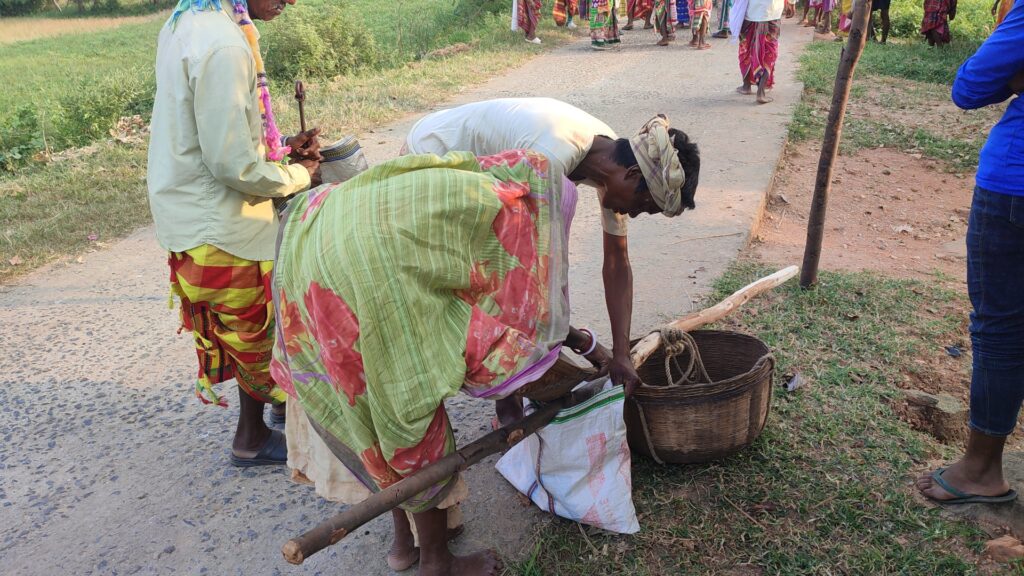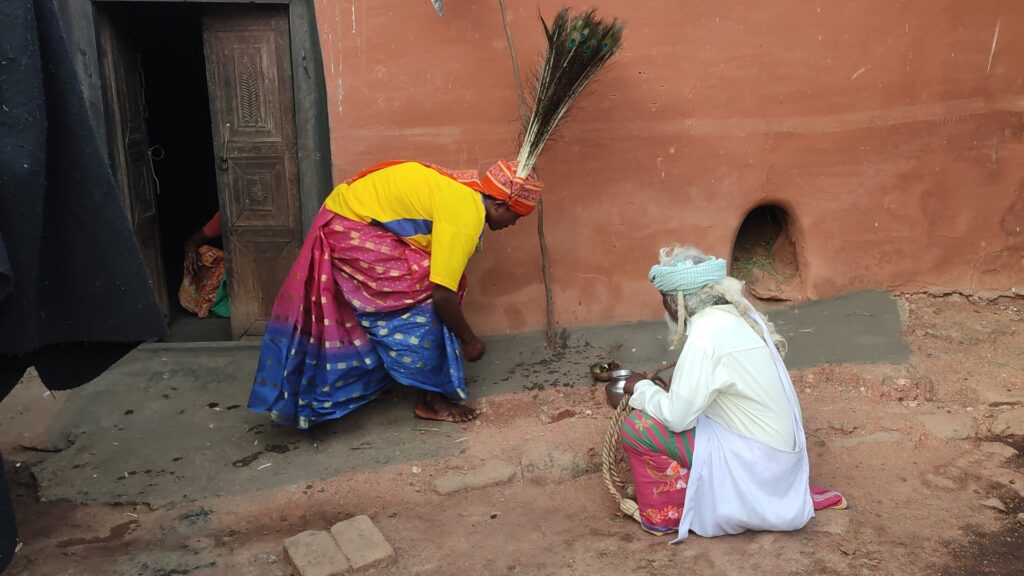Eight-year-old Budhuram Tudu had picked up the Dasai movements by simply watching his group practise their yearly Dasai dance in Barelhor village in the Ajodhaya hills of Purulia[i], West Bengal. Barelhor belongs to the last 3-4 villages out of the 192 villages in the Ajodhaya hills, where this Santhali cultural practice has still been kept alive. Thakurnath Chare now nearing 70, of Baruajara village, recollected how in his younger days he would dance the Dasai and said ‘Since the past few years it has not been performed in Baruajara but earlier every village would do the Dasai.’ The reason he believed is not simply the migration of youth from the villages but the inability to foster the guru–shisha relationship that forms the bedrock of this practice. ‘Most of the old gurus have passed away and unfortunately, they have not been able to leave back the disciplined system required for Dasai to stay alive,’ rued Thakurnath. He went on to share his tales of travel as a Dasai dancer when a group consisted of a minimum of thirty men, while now there were only ten to fifteen in a group. The guru of Barelhor proudly shared how he learned this knowledge, ‘I was trained by my father-in-law who was the earlier guru of the village and I had to live and practice in a cave of our Marang Buru[ii] for twelve years.’ The guru is not simply entrusted with the duty of Dasai but can be responsible for performing other rituals and practices in the village too.
Dasai is a dance form of the Santhals which is performed in October as part of the sharad-utsav[iii]when men of the village under their guru travel to different villages performing Dasai and collecting grains and/or money which people of those villages offer on a completely voluntary basis. On the last day, they travel back to their respective village where they perform one final time, ending in a grand feast and celebration comprising mostly of the money and grains collected during their travels. Before the Dasai group leaves the village, there are rituals which are performed in the village by the guru, to protect them from the various evil spirits and beasts that they might encounter.

Hikim Mandi, a kabiraj[iv] of Tarpania village and former guru who would teach Dasai earlier said sarcastically ‘ekhun shobai VIP hoi geche’ which means people now feel they have become too ‘modern’ to be associated with such old traditions. Though still performed in the neighbouring districts of erstwhile Jungle Mahals, there is no denying that Dasai has become a rare practice. Simultaneously there is a rigorous movement to revive it and social media plays a major role in this. The essence of this cultural art form lies in the alternative narratives that it fosters around the major Hindu and Bengali festival of Durga Puja. Nakul Baskey the Parganait[v] of Baghmundi Pargana shared that Durga Puja is a comparatively recent phenomenon and earlier the puja would be known by other names such as Sarada Puja. Whereas the story of Dasai, he shared, originated from much earlier, when it was believed that the Aryans and non-Aryans[vi] were at war in the Satya Yug. During those times there was a brave king Hudur Durga (or Daraga)who was revered as a God among the non-Aryans and he was also believed to be a keeper of the buffalos. Though the Aryans made numerous attempts to defeat the non-Aryan king but were unsuccessful and came up with a strategy to trick and manipulate him using a beautiful woman, called Devi. The story goes that Devi was made to appear desolate and the king offered her shelter out of compassion. Another version mentions that Devi was offered in marriage to Hudur Durga as a sign to maintain peace. Either way, Devi ultimately betrays Hudur Durga one night by signalling the Aryans to come and attack at a moment when Hudur Durga is in a state of revelry. The guards of his kingdom were caught by surprise but fought bravely. When a few of the guards went to inform their king and queen, they were unable to find them anywhere inside the palace. The non-Aryans then fled to forests to escape the attack but promised themselves that they would go in search of their Hudur and Devi since they were unaware of Devi’s betrayal. Hence, they got divided under several gurus and began seeking Hudur and Devi, in their disguised selves from house to house acting like they were simply performing a dance and song. Dasai men therefore disguise themselves as women by wrapping women’s sarees as dhotis. They use an instrument which is made of a hollow bottle gourd, the strings of which when plucked produce a sound similar to a gunshot- bhuang, from where this instrument gets its name. Another instrument which is unique to Dasai is the kasha thala (bronze plates) which they bang together to again produce a blast-like sound. The refrain of ‘hai re hai re’ is often heard in Dasai as they mourn their loss. Surya Hasda[vii] in his article on Dasai, translates a few lines of such a song from Santhali to Bengali, the English of which goes as:
‘Hai re Hai re-
Devi o Durga both have gone
Devi o Durga both have left
Hai re Hai re-
Oh guru why did both of them go away
Oh guru why did they both leave?
Hai re Hai re
Oh shishya they both have left for this land only
Oh shishya they both have left for this earth only.’
There are other narratives similar to this one but differ a bit. For instance, in the ‘Voice of Jungle Mahal,’ a popular social media channel, an episode on Dasai, presents a story[viii] where a Santhal king, Hudad, is defeated by the Goddess Durga and hence the refrain of the ‘hai hai’ in the Dasai dancing and singing. In an article in the Forward Press[ix], Hudad Duraga is said to be a famous and strong king of the Kherwals /Santhals who was betrayed and poisoned by a beautiful girl sent by the dikus (non-Adivasis). In memory of this incident then the Santhal men took to Dasai song and dance to keep their histories and culture alive.
In the context of these indigenous and Adivasi versions which are mostly oral and have only recently started being written about, the Aryans’ are considered to have changed the discourse, and appropriated it to make Durga their light-skinned Goddess and the non-Aryans’ revered king, the dark-skinned monster, Mahi-asur who is depicted with a buffalo.

Dasai often finds space in the program schedule of various government and tourism shows on a stage that completely decontextualises and depoliticises the dance form; robbing it of possessing a narrative of its own. Simultaneously as Nakul puts it ‘the acceptability of a single narrative about the Durga Puja festival is not that of the triumph of good over evil but rather a constant reminder of what the non-Adivasis did and are still doing to suppress the Adivasi voices.’
[i] A district situated in the southwestern part of the state, sharing its border with Jharkhand.
[ii] Marang buru is believed to be the main god of the Santhals, the literal translation is ‘big mountain.’ It is one of the hills in the range of the Ayodhaya range.
[iii] Sharad corresponds in the western calendar from mid-september to mid-november. Whereas utsav means festival.
[iv] A person possessing the skills and knowledge to heal people.
[v] The head of a ‘pargana’ which is the administrative unit still followed in santal ways of life.
[vi] The Aryans are supposedly the race that entered the Indian subcontinent thousands of years ago while the non-Aryans are the indigenous communities. This racial and invasion theory is highly contested and political.
[vii] In the book ‘Adivasi Jagat’ (2017).
[viii] https://www.youtube.com/watch?v=8QbxB2IuFgU
[ix] https://www.forwardpress.in/2017/06/dasai-dance-symbol-of-resistance-to-arya-invasion/
***
Mrinalini Paul is a PhD researcher at the Tata Institute of Social Sciences (TISS) Mumbai.

Very good information and analysis about Dansai festival of Santal community. There are many myths on dansai.